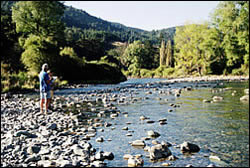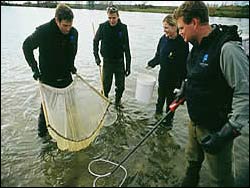Stream health – productivity
Research Status: Past |
Stream survey |
Introduction
What is driving the food chain in the Motueka River?
On a farm it’s obvious that the more grass that you grow, the more sheep or cattle that you can produce. In rivers the same situation applies. The only difference is that there are two distinct sources of ‘grass’ that may drive the system - algae that grow within the river and terrestrial plant material that grows on the land, but eventually ends up in the river. Some types of invertebrates that live in rivers rely on algae as their main food supply, while others love eating tree leaves. Therefore the relative importance of these two sources of food has a big impact on the numbers and types of stream invertebrates, and subsequently fish, that a river will support.
Current theory on the way that undisturbed river ecosystems work is that the headwaters of forested rivers are primarily fuelled by inputs of terrestrial material. Algae are more important food sources in the mid-reaches of rivers where the channel is wider making a gap in the forest canopy and allowing more sunlight for algal photosynthesis. The lower reaches of really large rivers are often fuelled by terrestrial inputs again because little light is able to reach algae growing on the bottom of a deep and turbid river.
The relative contribution of terrestrial and aquatic food sources for a reach of a river can be determined using measurements of ecosystem metabolism - the combination of algal production and ecosystem respiration (oxygen uptake). These measurements are made using changes in dissolved oxygen concentration over a 24 hour period. During daylight, algal photosynthesis increases the oxygen in the water, while at night oxygen concentrations decrease due to continual respiration by fish, invertebrates and microorganisms.
Research Approach
The relative contribution of terrestrial and aquatic food sources for a reach of a river can be determined using measurements of ecosystem metabolism - the combination of algal production and ecosystem respiration (oxygen uptake). These measurements are made using changes in dissolved oxygen concentration over a 24 hour period. During daylight, algal photosynthesis increases the oxygen in the water, while at night oxygen concentrations decrease due to continual respiration by fish, invertebrates and microorganisms.
Nine sites along the length of the Motueka River in winter (July 2001) and summer (March 2002). Water quality and light were measured at each of the sites in conjunction with the oxygen measurements.
Research Results
Patterns of algal production and community respiration down the length of the Motueka River are similar to what is predicted by current river ecosystem theory with the upper reaches of the river being primarily fuelled by terrestrial material.
On an international scale the Motueka River is relatively small and the lower reaches are still sufficiently shallow and clear to enable light to reach the riverbed, allowing relatively high rates of algal photosynthesis. Algal production in the lower Motueka is high enough to result in abundant high-quality food for grazing invertebrates, but does not appear to be too high and nuisance blooms of algae are uncommon. Grazing invertebrates make up the majority of the diet of trout and other freshwater fish in New Zealand rivers and their abundance is one explanation for the abundant fish populations in this reach of the Motueka River.
This provides a partial explanation for the abundance and vulnerability of the Motueka River's trout population.
 |
 |
Electric fishing |
Algae on stream cobbles |
Recent Publications
BMPs, BEPs and Guidelines
| Title | Description |
| Microbiological Water Quality Guidelines for Marine and Freshwater Recreational Areas |
From guide: The Microbiological Water Quality Guidelines for Marine and Freshwater Recreationa...More » |
| Contaminated Land Management Guidelines – Schedule A: Hazardous Activities and Industries List (HAIL) | |
| Clean Streams: A Guide to Managing Waterways on Tasman – Marlborough Farms |
From booklet: This booklet provides information about how to manage waterways to improve water...More » |
| Dairying and the Environment: Farm Management Issues |
From manual: The purpose of this manual is to provide guidelines to dairy farmers and their ad...More » |
| Dairying and the Environment: Managing Farm Dairy Effluent |
From manual: The purpose of this manual is to assist dairy farmers and farm management special...More » |
| Making Dollars and Sense of Nutrient Management: 7 steps to success |
From booklet: This booklet has been developed as a practical guide to sustainable nutrient man...More » |
| A User Guide for the Macroinvertebrate Community Index |
From website: This guide provides an expert view on best–practice use of the Macroinvert...More » |
| Check, Dlean, Dry: Didymo Factsheet for Whitebaiters |
From website: Whitebaiters need to clean nets and other gear betweeen waterways to help slow t...More » |
| A Guide to Managing Farm Dairy Effluent – Tasman/Marlborough |
From booklet: This booklet provides best management practices for the main systems currently o...More » |
| New Zealand Periphyton Guideline: Detecting, Monitoring and Managing Enrichment of Streams |
From MfE website. A background review of the structure and value of periphyton communities in ...More » |
| Stream Periphyton Monitoring Manual |
From guide: Describes a standard set of methods to enable Regional Councils, consultants and r...More » |
Primary Contacts:

|
Roger Young
Email Phone: (03) 548 2319 Fax: (03) 546 9464 |
Institute Cawthron Institute |
Expertise Land/water interactions, water quality, fisheries, river health |